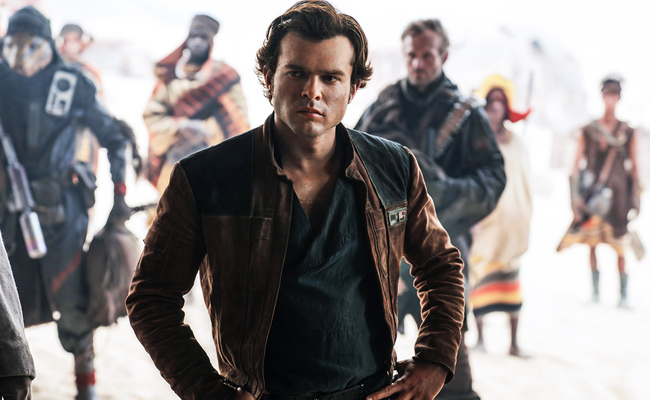
Solo: A Star Wars Story is enough of a mixed bag that it will end up being as divisive as all the other Disney Star Wars movies — probably inevitable when the original directors get replaced in the middle of production. But even in terms of Disney products in which the director got canned, Solo works better than Ant-Man (and in both cases I’d still love to see the respective Lord & Miller version of Solo and the Edgar Wright version of Ant-Man that Disney thought were too risky).
That troubled production history is perhaps reflected in Solo‘s shaky first half (Alden Ehrenreich’s Han and Emilia Clarke’s Qi’ra struggle to spice up the exposition-heavy dialog) and the weirdly flat, largely colorless production design — an area in which the other new Star Wars have been notably excellent (I can still practically feel Ben Mendolsohn’s gore-tex cape from Rogue One).
But Solo ultimately works, and if it has one saving grace, it’s the choice of protagonist. In the run-up to the first of Disney’s Star Wars movies, The Force Awakens, directed by JJ Abrams, there was a popular YouTube video going around called “Dear JJ Abrams,” in which a narrated animatic listed all of the “rules” of the Star Wars universe that Abrams should supposedly follow in order not to screw it up. It was mostly about as obnoxious as any fan video claiming ownership over a thing they didn’t create, but one of its more memorable assertions was “Star Wars is a Western.”
By “Western,” they meant mainly that it was dirty and set on the frontier, “amidst smugglers and bounty hunters.” But in terms of character arcs and conflict, if Star Wars is a Western, it’s mostly an old, white hat Western, a morally simplistic tale of good vs evil in which the bad guy dresses all in black and the good guy is a celibate monk. The good vs. evil aspect of Star Wars is, frankly, kind of boring, and so is the franchise if you think of Luke Skywalker as the hero.
If Han is the protagonist, on the other hand, it becomes an entirely different story — more of a revisionist, Spaghetti western-style western, complete with an antihero. That is, a protagonist who doesn’t fight for grand principles and is mostly just trying to survive. I think that’s what the Dear JJ Abrams guys were getting at, even if they didn’t know it. Anyone who’s invested in the mythology of Star Wars as more than a cool space story for little kids needs Han most of all. Han is the antihero. Good and evil is great for kids, but as adults moral complexity is much more compelling. As a book I was reading recently put it (The Rising Sun, by John Toland): “To the Japanese, a man without contradictions could not be respected; he was just a simple person. The more numerous the contradictions in a man, the deeper he was. His existence was richer the more acutely he struggled with himself.”
Han’s arc is Star Wars the way we want to remember Star Wars. Why do you think “Han shot first” is the biggest controversy of the Star Wars Universe? It’s because George Lucas saying Greedo shot first was tantamount to retconning Han into a Babyface. If Han shot first, he’s a Clint Eastwood character, a swaggering badass — not bad, exactly, but not afraid to get his hands dirty either. More importantly, he retains the capacity to be a son of a bitch on occasion. If he was just reacting, he could be any hero. It’s the difference between Han-as-hero and Han-as-antihero in a single disagreement.
The age of superheroes has made us all the more desperate for antiheroes (in Black Panther, simply having a villain who seemed like he might have a point was enough to be refreshing). Solo gets off to a shaky start, including doing the thing that all prequels and remakes seem to think they need to do these days, which is explain the protagonist’s name. So we find out why “Han Solo” is called “Han Solo,” something we didn’t need to know any more than we needed five scenes explaining the meaning of “Hope” in “A New Hope” from Rogue One, or a scene where we find out why “Johnny Utah” is named “Johnny Utah” in the Point Break remake. For the record, it’s because Johnny Utah’s mother was a Ute Indian. It means “mountain people.” Maybe that’s why he was so good on the slopes (please see this movie, it is so ridiculous).
Eventually, Solo settles in and becomes about Han’s contradictions. It becomes about the question of whether Han will do “the right thing” in a situation in which it doesn’t directly benefit him, and the whole film essentially turns on whether Han is the kind of guy who shoots first. The second half of basically any Star Wars movie consists of the characters running or chasing McGuffins from place to place, and that’s no different in Solo, but here there’s a moral underpinning. That’s ultimately what saves it from being forgettable. That and Dryden Vos, a scar-faced bad guy Paul Bettany plays with such shark-toothed menace that he’s easily the scariest villain of the franchise.
The beauty of Solo is shifting allegiances. You’re never entirely sure whether Han, Qi’ra, or Lando will end up doing the right thing. For all its parallels to the western, the character Han probably resembles most is a young version of Humphrey Bogart’s Rick Blaine in Casablanca. He’s the kind of guy who spends the entire movie telling people that he’s a son of a bitch and not to be trusted, but no one really believes it. But he repeats it often enough that he almost has you convinced. That’s a lot more interesting than a monk. And we could do a lot worse than space Casablanca.






